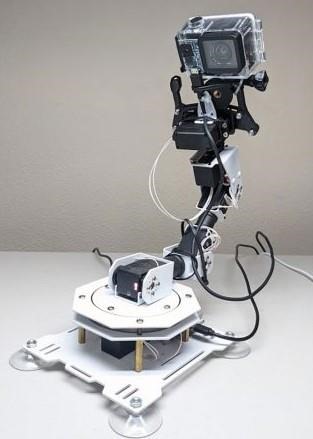Both teens showcased their research to the public on May 18 as part of the ISEF competition. Created by Society for Science, the fair moved online this year due to the COVID-19 pandemic. (The Society for Science also publishes Science News for Students.) This year, nearly 2,000 high school students from 64 countries, regions and territories showed off their projects online. With posters, videos and images to present their work, the teens competed for $5 million in awards.
Pinpointing plant thirst
Dry spells can stunt or even kill crops. Living in California’s Central Valley, John has seen lots of these droughts. A sophomore at Clovis North High School in Fresno, he wanted to help farmers save their plants from getting dangerously parched.
 John’s robotic arm can rotate in all directions, allowing him to measure the leaves of a plant, the soil and more.J. ESTRADA
John’s robotic arm can rotate in all directions, allowing him to measure the leaves of a plant, the soil and more.J. ESTRADA
The main model scientists use for drought stress in crops relies on measuring things such as how dry the air is above farm fields and how hot a plant gets. (John’s little sister, Pauline Estrada, used this model of drought stress when she built a plant-sensing rover. Based on this project, she was a finalist last fall in the Broadcom MASTERS competition. It’s held for middle-school researchers.)
John wanted to see if he could measure a plant’s drought stress more directly. So he built a small robotic arm and used it to measure the light reflecting off of bell peppers. As plants get dry, the way they reflect blue, green and red light changes very slightly. It’s not something that our eyes can see. But it is something a robot could detect. At the same time, his robot measured soil moisture and temperature.
With these data, he built a computer model. It predicts which plants will be suffering from thirst faster than other methods, John says. Identifying at-risk plants, he says, can point farmers sooner to where they should start watering — before their plants truly suffer. “Next year, I am planning to do a field experiment,” John says. He might even borrow his sister’s rover “to collect field data and adapt my … model to actual field conditions.”
Drones for drought
It’s also important to make sure that no irrigation water is wasted. That’s why Arya Tschand, 17, has been launching his drone into the sky. This senior at High Technology High School in Lincroft, N.J., aims to help poor farmers like the ones he saw while traveling in India.
“I would gaze in utter disbelief across endless fields of wilted crops,” he says. The problem, he learned, was water shortage. So Arya set out to find ways to limit water waste.
Click here to see more...